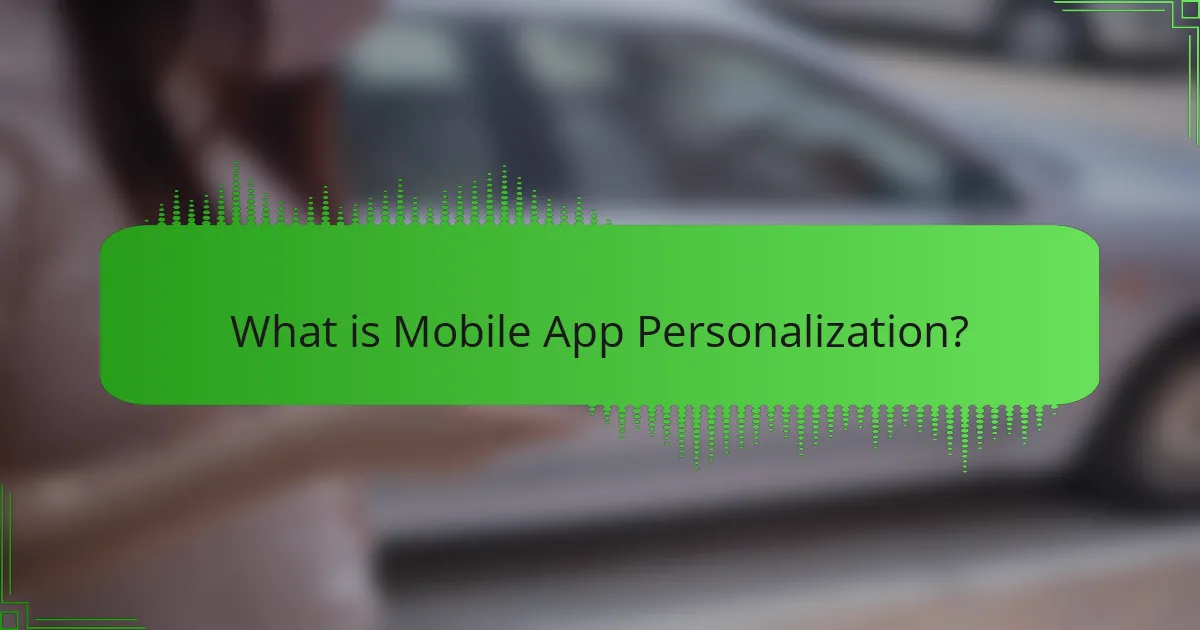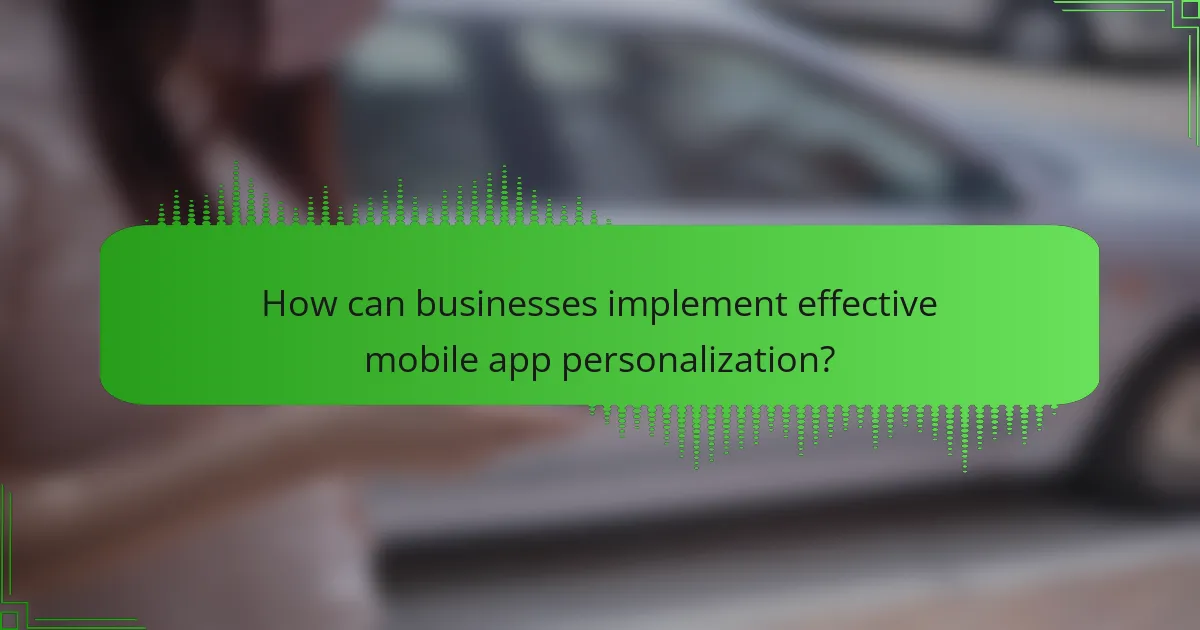Mobile app personalization refers to the process of customizing app experiences based on individual user data, including preferences, behaviors, and demographics. This approach enhances user satisfaction and engagement, ultimately leading to increased app usage and retention. Key techniques of personalization include content personalization, behavioral personalization, location-based personalization, demographic personalization, and predictive personalization. Effective implementation involves collecting and analyzing user data to create tailored experiences, such as personalized notifications and recommendations. Utilizing machine learning and A/B testing further refines these strategies, ensuring they resonate with users and adapt over time.

What is Mobile App Personalization?
Mobile app personalization is the process of tailoring app experiences to individual users. It involves collecting user data to understand preferences and behaviors. This data can include user location, browsing history, and interaction patterns. Personalized features may include customized content, notifications, and user interfaces. According to a study by Accenture, 91% of consumers are more likely to shop with brands that provide relevant offers and recommendations. Personalization enhances user satisfaction and engagement, leading to increased app usage and retention.
How does Mobile App Personalization enhance user engagement?
Mobile app personalization enhances user engagement by tailoring experiences to individual preferences. Personalized content increases relevance, making users more likely to interact. According to a study by Epsilon, 80% of consumers prefer personalized experiences. This leads to higher retention rates and increased usage frequency. Personalized notifications also drive user actions, as they provide timely and relevant information. Furthermore, users are more likely to share personalized content, expanding the app’s reach. Overall, personalization creates a more engaging and satisfying user experience.
What are the key elements of effective mobile app personalization?
Key elements of effective mobile app personalization include user data analysis, tailored content, and adaptive interfaces. User data analysis involves collecting and interpreting user behavior and preferences. Tailored content refers to personalized recommendations and notifications based on individual interests. Adaptive interfaces adjust the app layout and features according to user interactions and needs. These elements enhance user experience and engagement. Studies show that personalized experiences can increase user retention by up to 30%.
How does user data influence personalization strategies?
User data significantly influences personalization strategies by enabling tailored experiences for individuals. This data includes user behavior, preferences, and demographics. Analyzing such information allows businesses to create relevant content and recommendations. For instance, e-commerce platforms use past purchase data to suggest similar products. Research shows that personalized recommendations can increase conversion rates by up to 300%. Moreover, user data helps in segmenting audiences for targeted marketing campaigns. By understanding user journeys, companies can optimize app features to enhance engagement. Ultimately, leveraging user data leads to improved satisfaction and loyalty.
Why is user engagement important for mobile apps?
User engagement is crucial for mobile apps because it directly impacts retention and user satisfaction. High engagement levels lead to increased usage frequency and longer session durations. According to a study by Localytics, engaged users are 3 times more likely to continue using an app after the first week. This retention is essential for building a loyal user base. Engaged users also contribute to higher revenue through in-app purchases and advertisements. A report by App Annie indicates that apps with high user engagement see a 30% increase in revenue compared to those with lower engagement. Therefore, fostering user engagement is vital for the success and profitability of mobile apps.
What metrics indicate strong user engagement?
Strong user engagement is indicated by metrics such as session duration, daily active users, and user retention rate. Session duration measures how long users spend in the app during each visit. Longer session durations typically reflect higher engagement levels. Daily active users quantify the number of unique users interacting with the app each day. A growing number of daily active users suggests increased user interest and engagement. User retention rate indicates the percentage of users who continue to use the app over time. Higher retention rates demonstrate that users find value in the app, contributing to sustained engagement. Additionally, metrics like the number of in-app interactions and user feedback can further highlight engagement levels. Collectively, these metrics provide a comprehensive view of user engagement within a mobile app.
How does user engagement impact app retention rates?
User engagement significantly impacts app retention rates. Higher engagement levels lead to users returning more frequently. Engaged users are more likely to explore app features and content. This exploration fosters a deeper connection with the app. According to a report by Localytics, apps with high engagement can see retention rates increase by up to 200%. Frequent interactions encourage users to perceive the app as valuable. Retained users often drive organic growth through word-of-mouth. Therefore, enhancing user engagement is crucial for improving retention rates.

What are the different types of personalization techniques?
Personalization techniques can be categorized into several types. These types include content personalization, which tailors content based on user preferences. Another type is behavioral personalization, which adapts experiences based on user actions. Location-based personalization uses geographical data to customize content and offers. Demographic personalization considers user demographics like age and gender for targeted messaging. Lastly, predictive personalization leverages data analytics to anticipate user needs and preferences. Each technique aims to enhance user engagement by providing relevant experiences.
How do behavioral personalization techniques work?
Behavioral personalization techniques work by analyzing user data to tailor experiences. These techniques utilize data such as browsing history, preferences, and interactions. Algorithms process this data to identify patterns and trends in user behavior. The insights gained allow for customized content, recommendations, and notifications. For instance, a mobile app may suggest products based on previous purchases. This targeted approach increases user engagement and satisfaction. Research shows that personalized experiences can boost conversion rates by up to 10%. Thus, behavioral personalization enhances the relevance of content for users.
What are examples of behavioral data used for personalization?
Examples of behavioral data used for personalization include user preferences, interaction history, and session duration. User preferences are indicated by the choices users make within the app. Interaction history tracks how users engage with specific features or content. Session duration measures the length of time users spend in the app during each visit. Additionally, frequency of app usage reveals how often users return. This data helps tailor content and recommendations to individual user needs. Personalization based on behavioral data can enhance user experience and engagement significantly.
How can behavioral insights be leveraged for better user experiences?
Behavioral insights can be leveraged for better user experiences by tailoring applications to user preferences and habits. Understanding user behavior allows developers to create personalized content and features. For instance, analyzing user interaction data can reveal which features are most engaging. This information can inform design changes that enhance usability. Additionally, behavioral insights can identify pain points in the user journey. Addressing these issues can lead to smoother navigation and increased satisfaction. Research shows that personalized experiences can boost user retention by up to 30%. By applying behavioral insights, app developers can create more relevant and engaging experiences for users.
What role does demographic data play in mobile app personalization?
Demographic data plays a crucial role in mobile app personalization. It enables developers to tailor content and features to specific user groups. This data includes age, gender, location, and income level. By analyzing demographic information, apps can deliver targeted recommendations. For example, a fitness app might suggest workouts based on age and fitness level. Research shows that personalized experiences can increase user engagement by up to 80%. Apps that utilize demographic data often see higher retention rates. This approach helps in creating a more relevant user experience.
How can age, location, and gender demographics enhance personalization efforts?
Age, location, and gender demographics enhance personalization efforts by allowing tailored content and experiences. Age influences preferences and behavior patterns. Younger users may prefer trendy features, while older users might seek simplicity. Location affects cultural relevance and contextual offerings. For instance, users in urban areas may favor different services than those in rural settings. Gender demographics can guide product recommendations and marketing messages. Research shows that personalized marketing increases engagement by 20% (McKinsey & Company, 2021). By analyzing these demographics, businesses can create more relevant and appealing user experiences. This targeted approach leads to higher user satisfaction and retention.
What are the risks of over-segmenting based on demographic data?
Over-segmenting based on demographic data can lead to several risks. One major risk is the potential for misinterpretation of user needs. When segments are too narrow, marketers may overlook broader trends that affect user behavior. This can result in ineffective campaigns that do not resonate with the target audience.
Another risk is reduced market reach. Overly specific segments may exclude potential users who do not fit the defined criteria but still have an interest in the product. This can limit growth opportunities and reduce overall engagement.
Additionally, over-segmentation can increase complexity in marketing strategies. Managing numerous small segments can strain resources and complicate decision-making processes.
Finally, it may lead to a lack of personalization. If segments are too rigid, marketers may fail to deliver tailored experiences that truly meet user preferences. This can diminish user satisfaction and loyalty over time.

How can businesses implement effective mobile app personalization?
Businesses can implement effective mobile app personalization by leveraging user data to tailor experiences. They should collect data on user behavior, preferences, and demographics. This data can be analyzed to identify patterns and trends. Businesses can then use these insights to create personalized content and recommendations. For example, personalized notifications can increase user engagement by 50%. Additionally, implementing machine learning algorithms can enhance personalization over time. A/B testing can help determine which personalized features resonate best with users. Finally, continuous feedback loops can refine personalization strategies based on user responses.
What tools and technologies facilitate mobile app personalization?
Tools and technologies that facilitate mobile app personalization include data analytics platforms, machine learning algorithms, and user feedback systems. Data analytics platforms, like Google Analytics, collect user behavior data. This data helps in understanding user preferences and habits. Machine learning algorithms analyze this data to predict user needs. They enable real-time personalization of content and features. User feedback systems, such as in-app surveys, gather direct input from users. This feedback informs developers about user satisfaction and areas for improvement. Together, these tools enhance user experience and engagement in mobile apps.
How do machine learning and AI contribute to personalization efforts?
Machine learning and AI enhance personalization efforts by analyzing user data to tailor experiences. They identify patterns in user behavior, preferences, and interactions. Algorithms process vast amounts of data to deliver customized content and recommendations. This leads to improved user satisfaction and engagement. For instance, Netflix uses AI to suggest shows based on viewing history. Similarly, Spotify curates playlists based on listening habits. Research indicates that personalized experiences can increase conversion rates by up to 10%. Therefore, machine learning and AI are crucial for effective personalization strategies in mobile apps.
What are the best practices for selecting personalization tools?
Identify the specific needs of your target audience when selecting personalization tools. Understanding user preferences is crucial for effective personalization. Evaluate the tools based on their ability to gather and analyze user data. Effective tools provide insights into user behavior and preferences. Consider integration capabilities with existing systems and platforms. Seamless integration enhances the overall user experience. Assess the scalability of the personalization tools. Scalable tools can adapt to growing user bases and data volumes. Review the tools’ performance metrics and case studies. Proven effectiveness in similar contexts validates their potential. Prioritize tools that offer customizable features. Customization allows for tailored user experiences. Ensure compliance with data privacy regulations. Adhering to regulations builds user trust and protects sensitive information.
What are common challenges businesses face with mobile app personalization?
Businesses face several common challenges with mobile app personalization. Data privacy concerns are significant. Users are increasingly wary of how their data is collected and used. This can lead to reluctance in sharing personal information. Limited understanding of user preferences also poses a problem. Businesses may struggle to accurately interpret user behavior and preferences. Technical limitations can hinder effective personalization. Not all apps have the infrastructure needed to implement advanced personalization features. Resource allocation is another challenge. Businesses may lack the budget or staff to invest in personalization technologies. Additionally, maintaining personalization over time can be difficult. User preferences can change, requiring ongoing adjustments to personalization strategies. These challenges can impact the overall effectiveness of mobile app personalization efforts.
How can privacy concerns affect personalization strategies?
Privacy concerns can significantly impact personalization strategies. Users may resist sharing personal data due to fears of misuse. This resistance can limit the data available for tailoring experiences. Consequently, businesses may struggle to create relevant and engaging content. Research indicates that 79% of consumers are concerned about how companies use their data. This concern can lead to decreased user trust and engagement. Additionally, strict privacy regulations can restrict data collection methods. Companies must balance personalization with transparency to address these challenges.
What strategies can mitigate personalization-related challenges?
Implementing user feedback mechanisms can mitigate personalization-related challenges. Gathering direct input from users allows for adjustments to be made based on their preferences. Regularly updating algorithms based on this feedback can enhance relevance. Data privacy measures also play a crucial role in building trust. Ensuring compliance with regulations like GDPR protects user information. Offering users control over their data encourages engagement. A/B testing different personalization strategies helps identify what works best. Analyzing user behavior patterns can reveal insights for more effective personalization. These strategies collectively improve user satisfaction and engagement in mobile apps.
What are practical tips for enhancing user engagement through personalization?
Utilize user data to tailor experiences for individual preferences. This includes analyzing user behavior, demographics, and feedback. Implement personalized content recommendations based on past interactions. For instance, apps can suggest products or articles aligned with user interests. Use targeted notifications to remind users of relevant features or offers. Research indicates that personalized messages can increase engagement by 50%. Create user profiles to enhance the personalization process. This allows for a more curated experience over time. Regularly update personalization strategies based on evolving user data. Keeping content fresh and relevant encourages ongoing user interaction.
Mobile app personalization is the process of customizing app experiences based on individual user data, such as preferences and behaviors. This article explores how personalization enhances user engagement, detailing key elements, techniques, and the impact of user data on retention rates. It also addresses the importance of user engagement metrics, the role of demographic data, and the challenges businesses face in implementing effective personalization strategies. Practical tips for leveraging data and tools to improve user satisfaction and loyalty are provided, emphasizing the significance of balancing personalization with privacy concerns.


